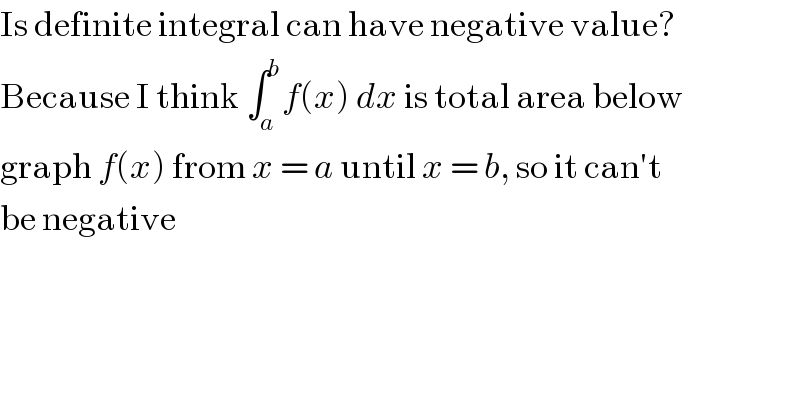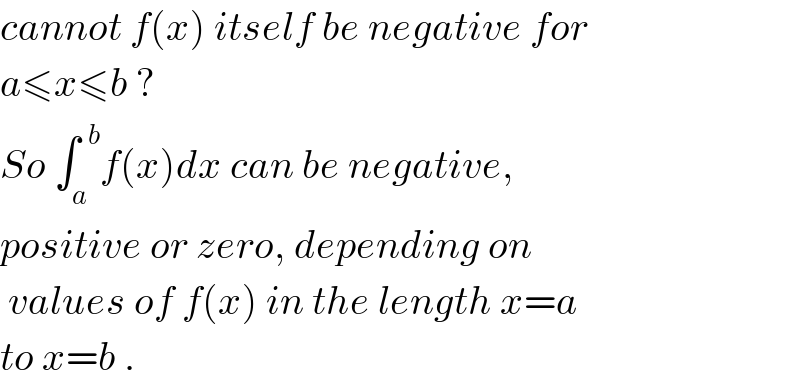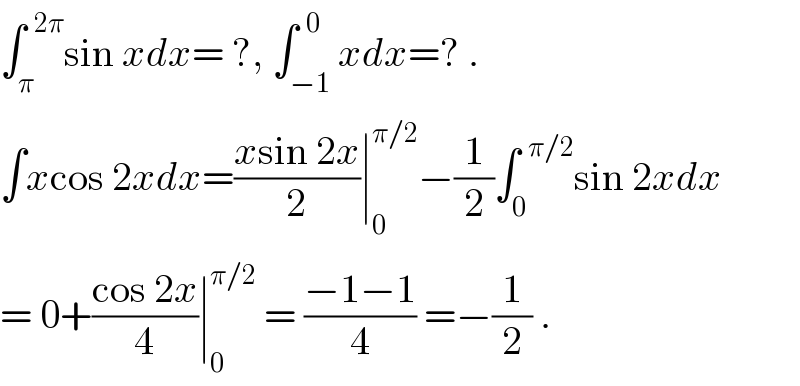
Question Number 20202 by Joel577 last updated on 24/Aug/17

$$\mathrm{Is}\:\mathrm{definite}\:\mathrm{integral}\:\mathrm{can}\:\mathrm{have}\:\mathrm{negative}\:\mathrm{value}? \\ $$$$\mathrm{Because}\:\mathrm{I}\:\mathrm{think}\:\int_{{a}} ^{{b}} {f}\left({x}\right)\:{dx}\:\mathrm{is}\:\mathrm{total}\:\mathrm{area}\:\mathrm{below} \\ $$$$\mathrm{graph}\:{f}\left({x}\right)\:\mathrm{from}\:{x}\:=\:{a}\:\mathrm{until}\:{x}\:=\:{b},\:\mathrm{so}\:\mathrm{it}\:\mathrm{can}'\mathrm{t} \\ $$$$\mathrm{be}\:\mathrm{negative} \\ $$
Commented by ajfour last updated on 24/Aug/17

$${cannot}\:{f}\left({x}\right)\:{itself}\:{be}\:{negative}\:{for} \\ $$$${a}\leqslant{x}\leqslant{b}\:? \\ $$$${So}\:\int_{{a}} ^{\:\:{b}} {f}\left({x}\right){dx}\:{can}\:{be}\:{negative}, \\ $$$${positive}\:{or}\:{zero},\:{depending}\:{on}\: \\ $$$$\:{values}\:{of}\:{f}\left({x}\right)\:{in}\:{the}\:{length}\:{x}={a} \\ $$$${to}\:{x}={b}\:. \\ $$
Commented by Joel577 last updated on 24/Aug/17

$$\mathrm{In}\:\mathrm{example}\:{I}\:=\:\int_{\mathrm{0}} ^{\pi/\mathrm{2}} {x}\:\mathrm{cos}\:\mathrm{2}{x}\:{dx} \\ $$$$\mathrm{the}\:\mathrm{result}\:\mathrm{is}\:−\frac{\mathrm{1}}{\mathrm{2}}.\:\mathrm{Is}\:\mathrm{it}\:\mathrm{true}\:\mathrm{or}\:\mathrm{not}? \\ $$
Commented by ajfour last updated on 24/Aug/17

$$\int_{\pi} ^{\:\:\mathrm{2}\pi} \mathrm{sin}\:{xdx}=\:?,\:\int_{−\mathrm{1}} ^{\:\:\mathrm{0}} {xdx}=?\:. \\ $$$$\int{x}\mathrm{cos}\:\mathrm{2}{xdx}=\frac{{x}\mathrm{sin}\:\mathrm{2}{x}}{\mathrm{2}}\mid_{\mathrm{0}} ^{\pi/\mathrm{2}} −\frac{\mathrm{1}}{\mathrm{2}}\int_{\mathrm{0}} ^{\:\:\pi/\mathrm{2}} \mathrm{sin}\:\mathrm{2}{xdx} \\ $$$$=\:\mathrm{0}+\frac{\mathrm{cos}\:\mathrm{2}{x}}{\mathrm{4}}\mid_{\mathrm{0}} ^{\pi/\mathrm{2}} \:=\:\frac{−\mathrm{1}−\mathrm{1}}{\mathrm{4}}\:=−\frac{\mathrm{1}}{\mathrm{2}}\:. \\ $$
Commented by Joel577 last updated on 24/Aug/17

$$\mathrm{But}\:\mathrm{if}\:\mathrm{I}\:\mathrm{separate}\:\mathrm{it}\:\mathrm{into} \\ $$$$\int_{\mathrm{0}} ^{\pi/\mathrm{4}} {x}\:.\:\mathrm{cos}\:\mathrm{2}{x}\:{dx}\:+\:\int_{\pi/\mathrm{4}} ^{\pi/\mathrm{2}} {x}\:.\:\mathrm{cos}\:\mathrm{2}{x}\:{dx} \\ $$$$\mathrm{it}\:\mathrm{isn}'\mathrm{t}\:−\frac{\mathrm{1}}{\mathrm{2}} \\ $$
Commented by ajfour last updated on 24/Aug/17
![[((xsin 2x)/2)+((cos 2x)/4)]∣_0 ^(π/4) +[((xsin 2x)/2)+((cos 2x)/4)]∣_(π/4) ^(π/2) =((π/8)−(1/4))+(−(1/4)−(π/8)) =−(1/2) .](Q20225.png)
$$\left[\frac{{x}\mathrm{sin}\:\mathrm{2}{x}}{\mathrm{2}}+\frac{\mathrm{cos}\:\mathrm{2}{x}}{\mathrm{4}}\right]\mid_{\mathrm{0}} ^{\pi/\mathrm{4}} +\left[\frac{{x}\mathrm{sin}\:\mathrm{2}{x}}{\mathrm{2}}+\frac{\mathrm{cos}\:\mathrm{2}{x}}{\mathrm{4}}\right]\mid_{\pi/\mathrm{4}} ^{\pi/\mathrm{2}} \\ $$$$=\left(\frac{\pi}{\mathrm{8}}−\frac{\mathrm{1}}{\mathrm{4}}\right)+\left(−\frac{\mathrm{1}}{\mathrm{4}}−\frac{\pi}{\mathrm{8}}\right)\:=−\frac{\mathrm{1}}{\mathrm{2}}\:. \\ $$
Commented by Joel577 last updated on 24/Aug/17

Commented by Joel577 last updated on 24/Aug/17

$$\mathrm{I}\:\mathrm{have}\:\mathrm{a}\:\mathrm{little}\:\mathrm{doubt}\:\mathrm{about}\:\mathrm{this} \\ $$$$\mathrm{The}\:\mathrm{area}\:\mathrm{between}\:\frac{\pi}{\mathrm{4}}\:\mathrm{and}\:\frac{\pi}{\mathrm{2}}\:\mathrm{is}\:\mathrm{below}\:\mathrm{x}−\mathrm{axis} \\ $$$$\mathrm{So},\:\mathrm{the}\:\mathrm{integral}\:\mathrm{must}\:\mathrm{be}\:\mathrm{positive},\:\mathrm{isn}'\mathrm{t}\:\mathrm{it}? \\ $$
Commented by Joel577 last updated on 24/Aug/17

$$\mathrm{Please}\:\mathrm{explain}\:\mathrm{with}\:\mathrm{more}\:\mathrm{detail}\:\mathrm{Sir}\:\mathrm{Ajfour} \\ $$
Commented by ajfour last updated on 24/Aug/17

$${The}\:{area}\:{from}\:\pi/\mathrm{4}\:\:{to}\:\:\mathrm{3}\pi/\mathrm{4}\:\:{is} \\ $$$${negative}. \\ $$
Commented by Joel577 last updated on 25/Aug/17

$${Understood}.\:{Thank}\:{you}\:{very}\:{much} \\ $$
